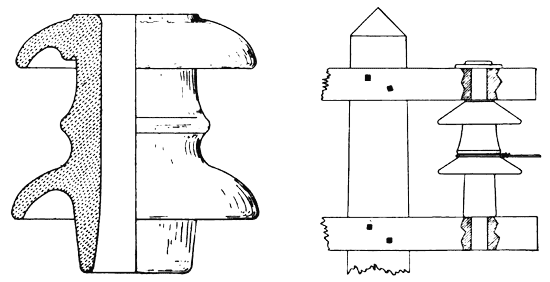[Trade Journal]
Publication: Electrical Age
New York, NY, United States
vol. 34, no. 5, p. 309, col. 2-3
High-Tension Strain Insulators
THE increase in the use of high-tension trolleys has created a demand for an insulator possessing mechanical and electrical qualities of a high order. To meet this demand the Locke Insulator Manufacturing Company, of Victor, N. Y., has brought out some new strain insulators for, voltages up to 35,000. One of these, designed for 8000 volts and measuring 6 inches in height and 5i inches in diameter, is shown in the annexed illustrations. A smaller design, for voltages of 5000 and under, has also been developed and found very useful in the construction of spans for trolley suspension, while a 60,000-volt pattern is now being developed.
 |
| An 8000-Volt Strain Insulator, Made by the Locke Insulator Manfuacturing Company, Victor, N. Y. It is Here Shown in Section and in Use for Dead-Ending A Live Wire. |
These insulators are used for dead-ending, for curves or similar use in holding live wires of high voltage, under excessive tension, the ordinary pin being too weak. The pin of the strain insulator is supported at both top and bottom, and the pull is transferred directly to the pole.
Either wood or iron pins may be used. The former are straight grained and treated with paraffins; the latter are of extra heavy standard pipe, provided with a special fitting at the top to cover the holes in the pipe and cross-arm. The iron pins include fibre tubes as a cushion between the insulator and the pin. Both the wood and iron pins are designed for cross-arms 41 inches thick, but extra length is allowed for thicker arms.
The pin holes in the insulators are all of larger diameter at the top and bottom, the smaller diameter being directly opposite the wire groove, so that the porcelain is always under direct compression only, though the pins flex somewhat under heavy load.
The mechanical tests of larger designs of these insulators have shown their ability to stand a break-down load of 12,000 pounds with the insulator supported by a pin through the middle and the load applied around the middle wire groove.
